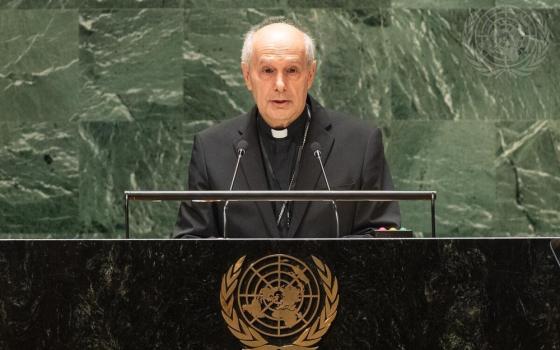When Pope Francis arrives in Washington, D.C., much of the media’s attention will undoubtedly focus on his address to a joint session of Congress — particularly on which elected officials will be chastened by the pontiff’s words.
Less attention will be paid to the controversy surrounding the pope’s canonization of Junípero Serra, which will take place the previous evening at the Basilica of the National Shrine of the Immaculate Conception.
Serra, an 18th-century Spanish friar who founded the first missions in California, is credited by the Catholic church for proselytizing and baptizing the indigenous people.
But Serra’s story is laced with disturbing details, many of which are well-presented by NCR’s Vinnie Rotondaro in his recent piece, “How Tarnished is Serra’s Halo?”
Rotondaro interviews Elias Castillo, who spent six years researching Serra and the records of California’s missions before writing his recent Cross of Thorns: The Enslavement of California’s Indians by the Spanish Missions.
For Castillo, as well as Valentin Lopez, chair of the Amah Mutsun Tribal Band of the Costanoan/Ohlone Indians, Serra was a religious zealot whose primary purpose was to save the souls of the indigenous, whom he saw as savages in desperate need of salvation through the church.
“The statistics kept by the friars were very, very detailed,” Castillo tells NCR. “Punishment records would name the Indians and how many lashes they received, and why they were being punished. Some of them were being punished simply for asking for more food.” They were often whipped for trying to flee the missions.
The indigenous people, who survived more than 10,000 years on the land we now call the United States, saw their population decimated by the punishments, European diseases, hard labor and malnutrition wrought by the missions.
As was widely reported in May, during his trip to Bolivia, Pope Francis offered an apology for the church’s treatment of the indigenous.
Much of Francis’ apology was a repeat of predecessor’s John Paul II’s words of contrition to native peoples in 1992 (during a trip to the Dominican Republic) and during the Jubilee in 2000:
“I say this to you with regret: Many grave sins were committed against the native peoples of America in the name of God,” Francis said during his trip to Bolivia in July. “Like Saint John Paul II, I ask that the Church ‘kneel before God and implore forgiveness for the past and present sins of her sons and daughters.’ ”
Like many of Serra’s apologists, Francis insists that the Spanish friar was a defender of the Indians against settlers and soldiers. It’s an argument that Serra biographer Steven Hackel says does not outweigh the harm ultimately done to native peoples.
“One can point to certain moments in the historical record when Serra does protect Indians, but the larger story I think is one in which his policies and his plans led to tremendous pain and suffering, most of it unintended on his part, among Native peoples,” Hackel recently told Al Jazeera America.
“There's no question that his goal was to radically alter Native culture, to have Indians not speak their Native languages, to practice Spanish culture, to transform Native belief patterns in ways that would make them much less Native. He really did want to eliminate many aspects of Native culture,” Hackel added.
Even in the face of such a troubling history, Pope Francis fervently fast-tracked Serra’s canonization process in time for his visit to the United States.
The pope scheduled the canonization before the Congregation for the Causes of Saints had completed its vetting process of Serra and before a second miracle was attributed to his intervention.
The Vatican’s saint-making office approved Serra canonization four months after the pope declared that he would make him a saint. According to the Associated Press, “a congregation official acknowledged that it would have been difficult for the members to have done otherwise given the canonization ceremony was already scheduled.”
Why would Pope Francis, champion of the poor and suffering, demonstrate such a strong desire to canonize a man who, history strongly suggests, opened the floodgates to so much abuse and oppression?
Speaking to seminarians at the North American College in Rome in May, Francis praised Serra as “part of a missionary corps who ‘went out to all the geographical, social and existential peripheries’ to spread the Gospel.”
"Such zeal excites us," Francis added.
Francis has made his desire for a new missionary form of Catholicism clear from the first paragraph of his first encyclical, Evangelii Gaudium (“The Joy of the Gospel”):
The joy of the gospel fills the hearts and lives of all who encounter Jesus. Those who accept his offer of salvation are set free from sin, sorrow, inner emptiness and loneliness. . . . In this Exhortation I wish to encourage the Christian faithful to embark upon a new chapter of evangelization marked by this joy.
Later in the encyclical, the pope clearly voiced his concern about a growing “spiritual desertification,” which is the result of the attempt of by “some societies to build without God or to eliminate their Christian roots. In those places ‘the Christian world is becoming sterile, and it is depleting itself like an overexploited ground, which transforms into a desert.”
Francis’ concern about the elimination of Christian identity was raised again in Bolivia in the same speech where he apologized for the treatment of indigenous people.
“Some powers are committed to erasing” Christianity, he said, “because our faith is revolutionary, because our faith challenges the tyranny of Mammon.”
Francis further warned against a “new form of colonialism” that has fostered inequality, materialism and the exploitation of the poor.
The strange irony is that Francis is using Serra, a missionary who sought to erase the culture and religion of one people, to try to counter the erasure of Christianity. He is using the founding father of religious colonialism to combat secular colonialism.
In the lead up to Serra’s canonization, some have argued that, to be a saint, you don’t have to be perfect, you only have to be holy.
But one is hard pressed to find much grace or holiness in Serra’s story. In the Gospel of Matthew, Jesus says, “By their fruits you shall know them.” What are the fruits of the work of Serra and the friars that followed him?
Today’s native people suffer disproportionate levels of poverty, depression and addiction. Experts say that this is evidence that the trauma inflicted centuries ago has been passed down from generation to generation. The loss of their identities, cultures and spiritualities is a “soul wound” inflicted in large part by the actions of the church. Is this the “good fruit” that Jesus called us to find?
Surely Pope Francis could have found a better model for evangelization that could speak to the contemporary longings and agonies of the Americas. Why not consider Sr. Dorothy Stang, whose love of the Gospel called her to defend the indigenous people of Brazil, and who was martyred while fighting the capitalist forces that continue to ravage the Amazon?
The canonization of Serra hearkens back to a pious, if not perilous, understanding of evangelization, and offers painful evidence that the institutional church still cannot manage to learn from its mistakes.
Worst of all, it will re-traumatize an already broken and forsaken people.
[Jamie L. Manson is NCR books editor. She received her Master of Divinity degree from Yale Divinity School, where she studied Catholic theology and sexual ethics. Her email address is jmanson@ncronline.org.]




